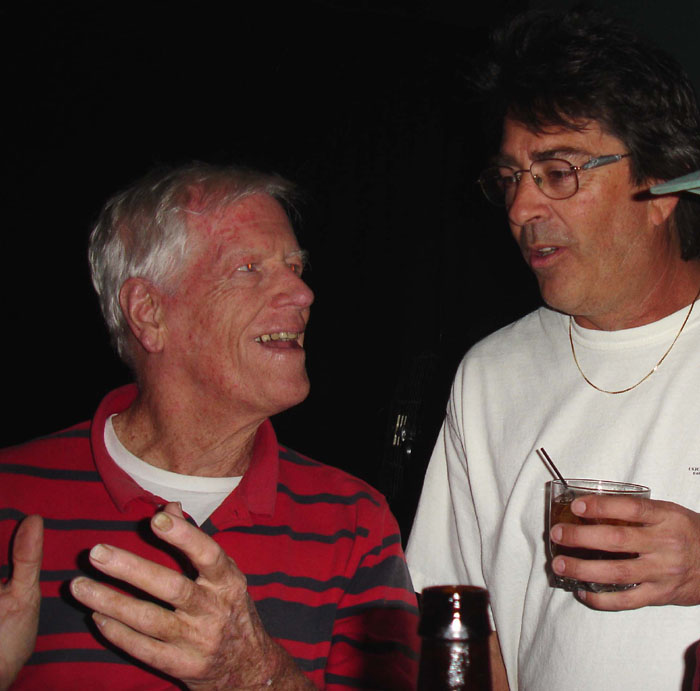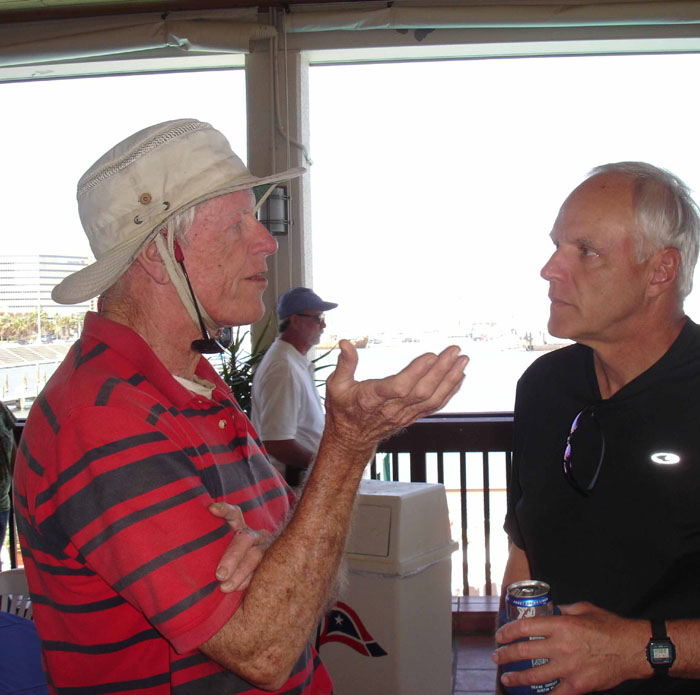|
Always smiling, forever giving
friendship .....
|
||
| You didn't know about it when we were in Austin - but we
do something now on downwind legs that we hadn't done before. It works
and gives us steady gains though small. We pump the mainsail, just a
little, but frequently. Scott showed us how well it worked in Corpus
Christi. Other boats typically don't do it, so advantage to us. I know - all I had to do is say something and you would have moved over. But I was more interested in what puffs you could see on the course, because those were major gainers when we found them. Next time we will try to do both - but finding those puffs was major. That was the first time anyone has really focused on finding the puffs. I felt as though we could have been trimmed a little tighter with the Genoa when we were on the second day. But I was willing to go with your call on the trim. The reason Stuart and the other boat were higher was because I was sailing to the tell tails. They told me to go lower. If you want me to go higher, consider trimming the sail in a little tighter. Everything has to work together - If that would have caused too much backwinding of the mainsail, I could have brought that in a little further. Remember, you can have backwinding of the front 30% of the sail. Now you start looking at speed vs pointing. If you are off speed, you may need to ease an inch and give up some of the pointing. At this point in trimming, you are beginning to see the parameters the pros play with. For a given weight on the boat, you can only go so fast, and point so high. The key is searching for the proper sail settings to optimize what you can get for a given wind and wave condition. The fact that we hike so hard, gives us an advantage, because we sail more like a fully loaded boat, and with Angel, it will be even better. The other thing that plays in this is the rig setting. That has to be right for the wind and wave conditions. I am only doing this notionally, based on what I have seen of our performance in different wind and wave conditions. The sail makers give us guidance for a fully crewed boat in flat water and then we need to make adjustments to accommodate our needs. Normally the rig is set for the lightest air you will see for a race, and then halyard tension, backstay, vang and mainsheet do the rest, to make the adjustments for the higher velocities. There are times during a race when I would like to make a halyard adjustment, but that isn't convenient. We could do that with the Genoa cunningham, which we have not been mounting. It is a refinement that we can throw in later, because it is not needed that often. When you are able to attend practices again, we can do more experimenting with the effect that trim has on speed and altitude. One thing to remember is that when you ease you need to remember to bring the sail back in to the proper location. If it stays eased then we lose performance. Guidance: In lulls, ease after we slow down to the speed we should be going in the lull - reason is that in a lull I can't go as fast as I am going now, so what we do is continue to go high for altitude while we are burning off speed to get to lull speed, then we put the bow down and ease the sail to the proper setting for the lull. When we get hit with a puff, we want to take advantage of the sudden wind shift aft and keep the boat as flat as possible. Easing the sail does both. Explanation: Imagine that we are going along, and I suddenly push the bow down 10°. The boat would heel over, and we would be on a partial reach. To correct that situation, we would ease the genoa and mainsail, maybe a couple of inches, to get rid of the heel and acknowledge that we were on a reach. The boat would flatten out and accelerate because it was no longer being held back by the heel angle and rudder action. When we are going along and get hit with a puff, this is equivalent to me pushing the bow down 10°. Ease the sails immediately, to get the acceleration, and turn the boat further to windward to take advantage of the increase in speed to gain altitude, then retrim for speed and altitude. When the puff goes away, I need to push the bow back down to where it was, to maintain speed. In the puff, the retrim can come very quickly - as soon as I turn up (which is immediately), you should be retrimming back to about where you were before the ease took place. Once we get the timing down, we are going to be a tad faster and higher. At the same time that we are doing the trimming, the crew should be hiking extra hard, to get that extra pressure on the sails for acceleration. Boy oh Boy, does that ever work!!!
|

|
|
